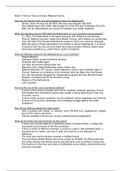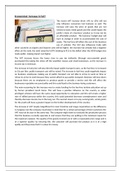Week 1: Roman Times and Early Medieval History
How can the Roman times and early medieval history be categorized?
- Roman Times: Roman Era (50 BCE-250) and Late Antiquity (250-400)
- Early Middle Ages (400-1000): Merovingian Era (500-750) and Carolingian Era (750-
900), can be characterized as a period of migration and “small” kingdoms
What did historians around 1900 think the Netherlands (or Low Countries) encompassed?
- P.J. Blok: The Netherlands is the logical outcome, with Holland as central area
- Pirenne: Belgium has been visible since Middle Francia, with Flanders as central area
- Geyl: the idea of the Greater Netherlands, based on Dutch as a common language
- Note that some of these explanations are finalistic in nature (teleological), it is wrong
to assume that only one outcome would have been possible, different states would
have been possible (e.g. under France, Spain or England)
What are different names for the Netherlands (or Low Countries)?
- Belgium/Belgica
- Germania Inferior (under the Roman Empire)
- Austrasia (late middle ages)
- Les Pays de par-deca (Burgundian era)
- Republic of the United Netherlands (early modern era)
- Batavian Republic (18th century, before Napoleon, when it was a satellite state of
France), Batavian is a reference to the Germanic tribe the Batavi from the Roman
era, who had already struggled for independence against the Holy Roman Empire
- Kingdom of Holland with for the first time a king)
- Kingdom of the Netherlands
- Low Countries
How can the role of the Low Countries be defined?
- In terms of the country’s location and role as “mediator” between Germany, France
and England (the international sphere was usually a strong determinant in the Low
Countries’ future)
- In terms of the country’s character, its civic (political) culture, egalitarian and Calvinist
- In terms of the country’s landscape, the everlasting struggle against the water
(“polderen”)
How did the defense against the water begin?
- With a coastline with “terpen” or “wierden” since 700 BCE (e.g. Hegebeintum, highest
terp is 8.8 m above sea level)
- Flemish coastline in Roman era, dunes crumbled during transgression
What are the limes and what functions do they have?
- A limes was a border defence or delimiting system of ancient Rome, it marked the
boundaries and provinces of the Roman empire
- It had a number of different meanings, it could be a path or balk delimiting fields, a
boundary line or marker, any road or path, any channel or any distinction or
difference
- The word was used to denote a marked or fortified frontier
- The river Rhine (Nether Rhine) also forms a limes (in 50 BCE), the Rhine becomes
the border between the Roman empire and Germania (Low Countries in Roma era)
- The functions of the limes and cities or fortifications serve military, administrative and
economic purposes
,What are important events that take place during the Roman era in the region of Germania?
- Julius Caesar conquests Gaul* in 57 BCE, later conquests are made by military
commander Drusus during the reign of August in 12 BCE
- In 69/70 BCE the Revolt of the Batavians, which led to a new defence policy
- There is a decline of the Roman empire around 350
- Formal end of the Roman empire is 406/407
*Gaul was a region of Western Europe that was inhabited by Celtic tribes, encompassing
present-day France, Luxembourg, Belgium, Switzerland, Northern Italy, parts of the
Netherlands and Germany on the west bank of the Rhine
How can the Roman era be described?
- There was limited Romanization (only in the South) and there is relative continuity
until 350
- There are Roman settlements along the Dutch coastline
- Roman culture was Christian; Christianization starts in late antiquity (250-400) and
only in the Romanized southern regions of Toxandria (Brabant), e.g. bishop in
Tongeren (Maastricht) in 400 is St. Servatius
- In late antiquity (250-400) there are economic contacts with neighbouring peoples,
however ethnic mixture is rare
When and why did the limes come under pressure?
- Around 200-400 the limes are under pressure, there is a crisis in the border area (so
around the Rhine), limes are under pressure by Franks, Saxons and Frisians
- Franks undermine the structure of the limes from inside as foederati
- Foederati: was any one of the several outlying nations to which ancient Rome
provided benefits in exchange for military assistance, the term was also used for
groups of “barbarian” mercenaries who were allowed to settle in the Roman empire
What are different names the Romans have for Germanic tribes in the area of the
Netherlands (Germania Inferior)?
- Frisii, Frisiavones, Batavii, Chamavi, Canninevates, Toxandri
In the early middle ages (400-1000) what continuities and discontinuities take place after the
fall of the Roman empire?
- There are the Franks (from Doornik in the South), the Frisians (from the coast and
Denmark) and the Saxons (from the North Sea area and England)
- There are confrontations between Franks and Frisians*
- There is discontinuity with the Roman empire, because:
Germans have kings (heerkonige) with military and sacral power based on
hereditary succession and division after the king’s death, which ultimately
leads to problems resulting from hereditary practices, this was different from
the Romans who lived under the rule of the Roman emperor
People move from cities (villae) to villages and domains
Germans have customary law (unwritten law) and “personaliteitsbeginsel”
(“leidende rechtsgedachte die inhoudt dat voor de vraag onder welk recht de
vreemdeling op een bepaald gebied left, de nationaliteit van die persoon
beslissend is”), this is different from codified Roman law
- There is continuity with the Roman empire, because:
Infrastructure (roads, but also cities) remain
Administrative: taxes, coining remain
Practices of clientelism and feudalism (vassality) remain
Christendom as a religion remains
*How can the confrontations between the Franks and Frisians be described?
, - Dagobert I tries to control the Frisians, concerning trade and religion (Christendom)
- Pepin I of Austrasia moves his centre to the North. Pepin II defeats the Frisian king
Redbad and conquers Utrecht and Dorestad in 690. Charles Martel* (son of Pepin II)
defeats the Frisians in 734 definitively
- Despite the conflicts between the Franks and the Frisians, there is a flourishing of
Frisian-Frankish trade around Dorestad (close to Utrecht)
*The dynasty officially ended with the death of Pepin II, who was succeeded by his son
Charles Martel, Charles Martel went on to found a new line of the family, which historians
named the Carolingian dynasty (after Martel)
What are important events that take place during the Merovingian era (500-750) in the region
of Germania?
- Childeric I (457-481), the son of Merovech (Merovingian), leader of the Salian Franks,
founded the Merovingian dynasty but it was his famous son Clovis I (481-511) who
united all of Gaul under Merovingian rule
- Rise of the Franks starts with Clovis I (481-511) in Gaul
- Orthodox Christendom is accepted* and appreciated by the nobles
- Dagobert I (625-639) supports old-Gallic clergy (Amandus) and particularly Anglo-
Saxon missionaries
*What does Christianization look like in the Frankish empire during the Merovingian era (500-
750)?
- Around 700-800 there is northward expansion by mayors of the palace of Charles Martel
and Pepin III
How can the Carolingian era (750-900) be described?
- The names Austrasia and Neustrasia disappeared when the area became one Frankish
empire under the Carolingians
- Early administrative units are gaus, later called counties, the gau (count=graaf) is the
administrative authority, this is not (yet) the landlord system (feudalism), furthermore, the
land is divided into Palatinates (palatia) and crown-properties (fisci), where the
Carolingian king can stay when he is travelling throughout the country
- However, feudalism and a domain-system does appear under the rule of the Franks, this
happens when the division of land and its ownership is made hereditary, however this did
probably not have much influence in the North
- There is a continuing Frisian-Frankish trade around emporia such as Dorestad
What contributes to the decline and disintegration of the Carolingian empire?
- Around 800-900 the impact of Viking raids was big, they damaged the unity of the
Carolingian kingdom and damaged trade and commerce
- However, the biggest contributor to the decline was the division and making hereditary of
territories where the local nobility claims role as protectors
- From 925 onwards, the Low Countries is divided by the Scheldt river, between the
German empire and France, however we still regard it as a unitary entity
, Week 1: Counties, cities and church during the high middle ages (1000-1300)
Shortly describe the political, economic and religious/cultural developments during the high
middle ages (1000-1300).
- Political: there is the development of the county of Flanders and the county of Holland,
bishops become lords (feudalism) and Frisia articulates its special role under the Frisian
Freedom
- Economic: there is land cultivation and dike-building and increased urbanization and the
establishments of new trades and crafts
- Religious/cultural: Christianization, there is building of churches (from wood to brick) and
increased writing and literacy (from Latin to vernacular)
What are the most important political developments during the high middle ages (1000-
1300)?
- There is political disintegration: there are different speeds concerning the creation of
political units and the shaping of new territories (some take the lead, while others stay
behind)
- This leads to political fragmentation, there comes a patchwork of domains and shape is
the result of coincidence, some of these areas were merged via personal unions
- Many leaders support the “peace of God”, meaning there should be an end to wars
leading to more economic welfare
- There is a decrease of power of the nobles, this is because there is a rise of cities and
towns and their trade, nobles who had been powerful, lost their power in the cities,
sovereign lords stimulated this development, because they knew that with a flourishing
economy their tax profit would rise
- During the Carolingian era the monasteries had close ties to the nobility, personal
connections were thus important
- There are different developments in Frisia, there are no lords and feudalism was not in
place, the Frisian Freedom signified that they would not accept to be ruled by a lord
How can you describe the development of the county of Flanders during the high middle
ages (1000-1300) under the House of Baldwin?
- Flanders become the first county in the Netherlands to emancipate and is the first to
become a separate district.*
- This starts around 850 with Baldwin I, who was granted lands and honors, which would
evolve into the county of Flanders
- Baldwin II (879-918) claims sovereignty of Flanders and pays homage to the French king,
thereafter he can consider Flanders his own, so Flanders becomes a separate district
under Baldwin II
- Baldwin V (1035-1067) builds up a professional bureaucracy. He divided Flanders into
districts that were controlled by castellani. The kasselrij organized the administration,
military power and judicial court. He also established water boards (water protection and
control, in this case against the Schelde), controlled by schepenen, civil servants who
were granted city rights for their work.
- The military around 1100 was impressive, (compared to e.g. France), the count of
Flanders could raise an army with thousand knights, the French only five hundred.
*Hainaut and Brabant started later with institution-building than Flanders, however they
became more successful, they “completed” their territories at the beginning of the thirteenth
century. Guelders and Holland are “completed” territories at the end of the thirteenth century.
How can you describe the development of the county of Flanders during the high middle
ages (1000-1300) under Charles the Good and the House of Alsace?
- Charles the Good (1119-1127) was a protector of the cities, he was a sovereign who
protected the city and was probably for that reason killed by the lower nobles, as his





